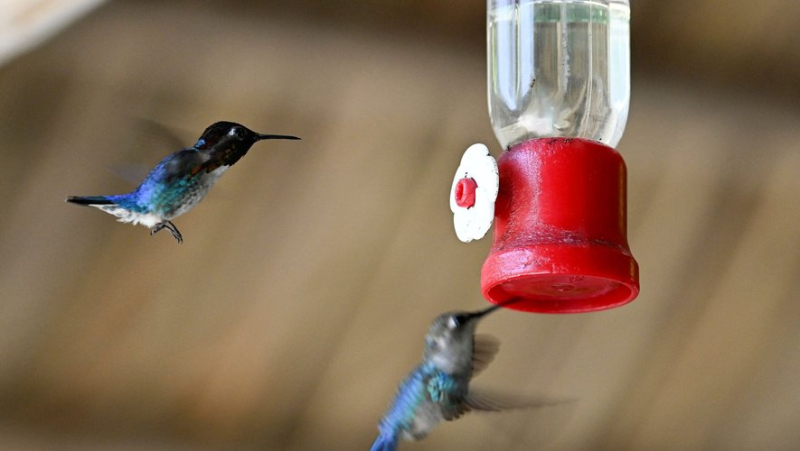'I thought it was a bug': Couple transforms their modest garden into a haven for the world's smallest bird

Found only in Cuba and listed as the smallest bird in the world, the hummingbird measures between 5 and 6 cm and its weight varies between 1.6 and 2.5 grams. YAMIL LAGE/AFP
Barely resting on a branch, it flies away again into the middle of the vegetation, making its tiny wings vibrate. In Palpite, in the southwest of Cuba, Bernabe Hernandez's garden has been transformed into a haven for the hummingbird, the smallest bird in the world.
"We never tire of it. We always discover something new!”, the septuagenarian enthuses as he observes two specimens swooping towards a small water trough suspended in the garden.
Present only in Cuba and listed as the smallest bird in the world, the hummingbird measures between 5 and 6 cm and its weight varies between 1.6 and 2.5 grams . Its scientific name is “Mellisuga helenae”. In French, it is also known as Elena's hummingbird.
The Cubans called it "zunzuncito", or the little "zunzun", a generic name given to hummingbirds in reference to the buzzing of their wings that can beat up to 100 times per second.
In the shaded garden where mango, guava and avocado trees flourish, half a dozen of these hummingbirds fly at high speed in the garden, under the amazed eyes of a few tourists, cell phones in hand.
Yet, nothing intended Bernabe Hernandez and his wife Juana Matos to turn their modest garden into this precious observatory, today called "La casa de los colibries" (The hummingbird house) and open to visitors.
It all started about twenty years ago when Bernabe had to start from scratch after Hurricane Michelle devastated his home in a hamlet located in the interior of the Cienaga de Zapata, the largest wetland in the Caribbean. The government allocated him equipment and land to rebuild a house in the village of Palpite, on the edge of Cienaga.
"I moved here, but there were no birds", he says. "I then sowed a 'ponasi' to provide shade and attract a few birds" , he says in reference to a shrub (Hamelia patens) whose fruits are known to attract birds.
"Insect"
But he doesn't know that the hummingbird is particularly fond of the nectar of the vermilion flowers of the "ponasi", and it doesn't take long for the first gourmands to appear.
"When I saw a 'zunzuncito' for the first time, I’ thought it was an insect, he says. He then decides to sow other "ponasi", which have the particularity of flowering all year round. Little by little the garden attracts hummingbirds which nest in an adjoining wood.
In addition to the hummingbird, it is possible to observe another species of hummingbird at Bernabe, a little larger (10 cm) and more common, the ;Ricord Emerald (Riccordia ricordii), present not only in Cuba, but also in some neighboring islands of the Caribbean.
Thanks to the advice provided by guides from the Cienaga de Zapata Natural Park, known for its remarkable diversity of bird species (175 species, migratory and endemic) Bernabe and Juana learned to make the precise mixture of water and sugar to pour into the drinkers and to clean them carefully to avoid fungus.
Thanks to their observations, the couple is inexhaustible on the behavior of the bird, whose male adorns its head in red during the breeding season, and which never ceases to intrigue scientists and visitors with its ability to fly backwards or hover.
For Orestes Martinez, also a native of Cienaga de Zapata and a renowned amateur ornithologist, the Bernabe sanctuary is beneficial for the hummingbird.
"This protects the bird. During the breeding season, the female more easily collects food for the chicks", he explains, while "Mellisuga helenae" is classified as a species "near threatened" by the International Union for Conservation of Nature (IUCN) which estimates its population between 22,000 and 66,000 individuals.
The guide recalls that when Hurricane Michelle hit the area in 2001, "the zunzuncito had disappeared, there were no more flowers, many died".
While it is impossible for Bernabe Hernandez to know how many hummingbirds visit his garden daily as their rapid flight complicates any counting, he says he sees them all year round. And is happy to know that Cuba "has the smallest bird in the world".




